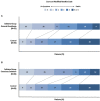Impact of Anesthetic Management on Safety and Outcomes Following Mechanical Thrombectomy for Ischemic Stroke in SWIFT PRIME Cohort
- PMID: 30210431
- PMCID: PMC6123376
- DOI: 10.3389/fneur.2018.00702
Impact of Anesthetic Management on Safety and Outcomes Following Mechanical Thrombectomy for Ischemic Stroke in SWIFT PRIME Cohort
Abstract
Background and purpose: The optimal anesthetic management of acute ischemic stroke patients during mechanical thrombectomy (MT) remains controversial. In this post-hoc analysis, we investigated the impact of anesthesia type on clinical outcomes in patients included in SWIFT PRIME trial. Methods: Ninety-seven patients treated with MT were included. Patients treated in centers with general anesthesia (GA) policy (n = 32) were compared with those treated in centers with conscious sedation (CS) policy (n = 65). Primary outcomes studied included times to treatment initiation (TTI), rates of successful recanalization (TICI 2b/3), and functional independence (mRS 0-2 at 90 days). Secondary outcomes were adverse events, lowest systolic and diastolic blood pressures (LSBP and LDBP) during MT. Univariate analysis and multivariate regression logistic modeling were conducted. Results: The GA-policy and CS-policy groups presented comparable TTI (94 ± 36 min vs. 102 ± 48 min; p = 0.44), rates of TICI 2b/3 recanalization (22/32 [68.8%] vs. 51/65 [78.5%]; p = 0.32). CS-policy was associated to higher rate of functional independence than GA-policy, but the difference was not significant (43/65 [66.2%] vs. 16/32 [50.0%]; p = 0.18). GA-policy patients had a higher rate of postoperative pneumonia (11/32 [34.4%] vs. 8/65 [12.3%]; p = 0.02) and lower LSBP (110 [30,160] mmHg vs. 119 [77,170] mmHg; p = 0.03) and LDBP (55 (15,75) mmHg vs. 67 [40,121]; p < 0.001). When corrected for differences in baseline characteristics, GA-policy was associated with lower rate of functional independence (OR 0.32; p = 0.05). A 10-point increase in perprocedural LDBP was associated with an increased likelihood of favorable outcome (OR 1.51; p = 0.01). Conclusions: GA-policy for MT presented comparable TTI and rates of successful revascularization to CS-policy. However, GA-policy was associated with lower rates of functional independence and with higher incidence of perprocedural hypotension and postoperative pneumonia. Clinical Trial Registration: URL-http://www.clinicaltrials.gov. Unique identifier: NCT01657461.
Keywords: acute ischemic stroke; blood pressure; conscious sedation; general anesthesia; mechanical thrombectomy.
Figures

References
-
- Berkhemer OA, Fransen PSS, Beumer D, van den Berg LA, Lingsma HF. A randomized trial of intraarterial treatment for acute ischemic stroke. N Engl J Med. (2015) 372:11–20. - PubMed
-
- Molina CA, Chamorro A, Rovira À, de Miquel A, Serena J, Roman LS, et al. . REVASCAT: a randomized trial of revascularization with SOLITAIRE FR device vs. best medical therapy in the treatment of acute stroke due to anterior circulation large vessel occlusion presenting within eight-hours of symptom onset. Int J Stroke Off J Int Stroke Soc. (2015) 10:619–26. 10.1111/ijs.12157 - DOI - PubMed
Associated data
LinkOut - more resources
Full Text Sources
Other Literature Sources
Medical

